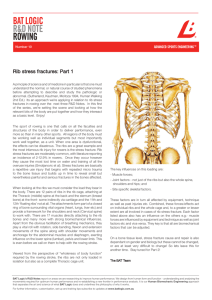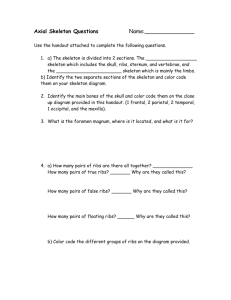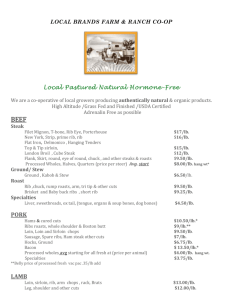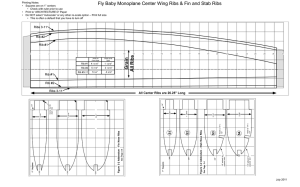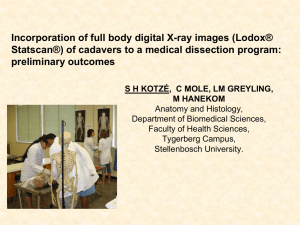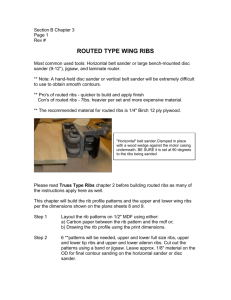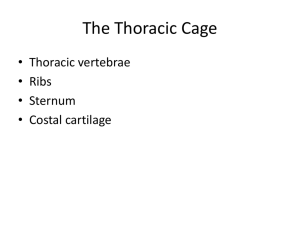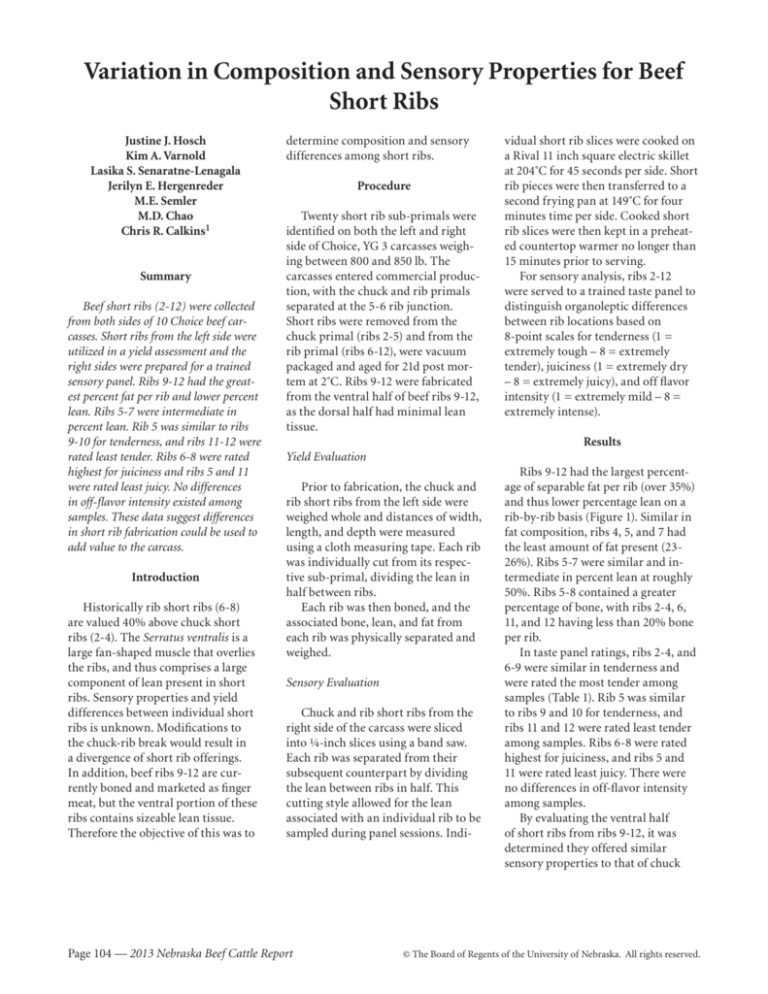
Variation in Composition and Sensory Properties for Beef
Short Ribs
Justine J. Hosch
Kim A. Varnold
Lasika S. Senaratne-Lenagala
Jerilyn E. Hergenreder
M.E. Semler
M.D. Chao
Chris R. Calkins1
Summary
Beef short ribs (2-12) were collected
from both sides of 10 Choice beef carcasses. Short ribs from the left side were
utilized in a yield assessment and the
right sides were prepared for a trained
sensory panel. Ribs 9-12 had the greatest percent fat per rib and lower percent
lean. Ribs 5-7 were intermediate in
percent lean. Rib 5 was similar to ribs
9-10 for tenderness, and ribs 11-12 were
rated least tender. Ribs 6-8 were rated
highest for juiciness and ribs 5 and 11
were rated least juicy. No differences
in off-flavor intensity existed among
samples. These data suggest differences
in short rib fabrication could be used to
add value to the carcass.
Introduction
Historically rib short ribs (6-8)
are valued 40% above chuck short
ribs (2-4). The Serratus ventralis is a
large fan-shaped muscle that overlies
the ribs, and thus comprises a large
component of lean present in short
ribs. Sensory properties and yield
differences between individual short
ribs is unknown. Modifications to
the chuck-rib break would result in
a divergence of short rib offerings.
In addition, beef ribs 9-12 are currently boned and marketed as finger
meat, but the ventral portion of these
ribs contains sizeable lean tissue.
Therefore the objective of this was to
determine composition and sensory
differences among short ribs.
Procedure
Twenty short rib sub-primals were
identified on both the left and right
side of Choice, YG 3 carcasses weighing between 800 and 850 lb. The
carcasses entered commercial production, with the chuck and rib primals
separated at the 5-6 rib junction.
Short ribs were removed from the
chuck primal (ribs 2-5) and from the
rib primal (ribs 6-12), were vacuum
packaged and aged for 21d post mortem at 2˚C. Ribs 9-12 were fabricated
from the ventral half of beef ribs 9-12,
as the dorsal half had minimal lean
tissue.
vidual short rib slices were cooked on
a Rival 11 inch square electric skillet
at 204˚C for 45 seconds per side. Short
rib pieces were then transferred to a
second frying pan at 149˚C for four
minutes time per side. Cooked short
rib slices were then kept in a preheated countertop warmer no longer than
15 minutes prior to serving.
For sensory analysis, ribs 2-12
were served to a trained taste panel to
distinguish organoleptic differences
between rib locations based on
8-point scales for tenderness (1 =
extremely­tough – 8 = extremely
tender), juiciness (1 = extremely dry
– 8 = extremely­juicy), and off flavor
intensity (1 = extremely mild – 8 =
extremely intense).
Results
Yield Evaluation
Prior to fabrication, the chuck and
rib short ribs from the left side were
weighed whole and distances of width,
length, and depth were measured
using­a cloth measuring tape. Each rib
was individually cut from its respective sub-primal, dividing the lean in
half between ribs.
Each rib was then boned, and the
associated bone, lean, and fat from
each rib was physically separated and
weighed.
Sensory Evaluation
Chuck and rib short ribs from the
right side of the carcass were sliced
into ¼-inch slices using a band saw.
Each rib was separated from their
subsequent counterpart by dividing
the lean between ribs in half. This
cutting style allowed for the lean
associated­with an individual rib to be
sampled during panel sessions. Indi-
Page 104 — 2013 Nebraska Beef Cattle Report Ribs 9-12 had the largest percentage of separable fat per rib (over 35%)
and thus lower percentage lean on a
rib-by-rib basis (Figure 1). Similar in
fat composition, ribs 4, 5, and 7 had
the least amount of fat present (2326%). Ribs 5-7 were similar and intermediate in percent lean at roughly
50%. Ribs 5-8 contained a greater
percentage of bone, with ribs 2-4, 6,
11, and 12 having less than 20% bone
per rib.
In taste panel ratings, ribs 2-4, and
6-9 were similar in tenderness and
were rated the most tender among
samples (Table 1). Rib 5 was similar
to ribs 9 and 10 for tenderness, and
ribs 11 and 12 were rated least tender
among samples. Ribs 6-8 were rated
highest for juiciness, and ribs 5 and
11 were rated least juicy. There were
no differences in off-flavor intensity
among samples.
By evaluating the ventral half
of short ribs from ribs 9-12, it was
determined­they offered similar
sensory­properties to that of chuck
© The Board of Regents of the University of Nebraska. All rights reserved.
100
13.71f
16.77e
19.19de
24.03abc
19.34de
49.18cd
50.47cd
25.05ab
26.60a
23.59bc
21.82cd
18.58e
17.96e
39.35f
40.53cd
41.75ef
45.87de
39.67a
36.18abc
90
80
Percent Composition (%)
70
56.36ab
51.79bc
60
57.79a
40.95cd
50
39.88f
40
30
41.05a
20
29.93def
10
31.44cde
23.03g
30.20def
26.80efg
25.00fg
33.52bcd
37.64ab
0
a,b,c,d,e,f,gSignifies
1Ribs
different superscripts; meaning values of the same tissue component are different at (P < 0.05).
respective to animal rib location. Ribs 9V, 10V, 11V, and 12V were collected from the ventral half of ribs 9-12.
Percent Fat
Percent Lean
Percent Bone
Figure 1. Least square means for short rib composition based on physical separation of tissue.
Table 1. Least square means for short rib sensory analysis
Sensory
short ribs. By adding the ventral half
of ribs 9-12 to US beef short rib offerings, an added 2.86 lb of short ribs
would be available, compared to 1.5 lb
from this location that would be marketed as beef rib fingers.
Given the similarities in tenderness, and increased yield values, short
ribs from the chuck sub-primal could
be added to that of the rib short rib
sub-primal. Chuck short ribs could
also be sold at a value similar to that
of rib short ribs.
property1
Rib2
Tenderness rating
Juiciness rating
Off-flavor rating
2
3
4
5
6
7
8
9V
10V
11V
12V
5.07abc
4.76bcd
5.11abc
5.21ab
4.72d
5.40a
5.28ab
5.32ab
5.02bcd
4.81de
4.31e
4.29e
4.89bcd
4.72cd
4.05f
5.29a
5.08ab
5.01abc
4.81bcd
4.61de
4.30ef
4.72cd
2.47
2.27
2.21
2.36
2.63
2.46
2.44
2.12
2.52
2.47
2.38
a,b,c,d,e,f,Means
in the same column with different superscripts are significantly different (P < 0.05).
property ratings based on an 8-point hedonic scale: tenderness (1 = extremely tough –
8 = extremely tender), juiciness (1 = extremely dry – 8 = extremely juicy), and off flavor intensity
(1 = extremely mild – 8 = extremely intense).
2Ribs respective to animal rib location. Ribs 9V, 10V, 11V, and 12V were collected from the ventral half
of ribs 9-12.
1Sensory
© The Board of Regents of the University of Nebraska. All rights reserved.
1Justine J. Hosch, graduate student; Kim A.
Varnold, graduate student; Lasika S. Senaratne,
graduate student; Jerilyn E. Hergenreder,
graduate student; Chris R. Calkins, professor,
University of Nebraska–Lincoln Department of
Animal Science, Lincoln, Neb.
2013 Nebraska Beef Cattle Report — Page 105

